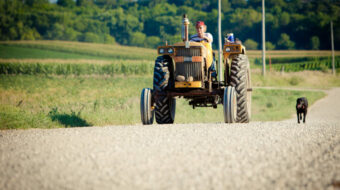The Arctic National Wildlife Refuge (pro-oil groups prefer its foreign-sounding acronym, ANWR) is ground zero in the War on the Environment. If the oil companies win the fight to drill there, no place will be off-limits for them again.
The pitch to drill in the Arctic Refuge isn’t new. In fact, if it wasn’t for public outcry after the Exxon Valdez oil spill, oil wells would likely already dot its landscape. What’s changed is that artificially high gas prices have made it easier for oil companies and the Bush Administration to manipulate Americans into supporting an energy policy that will lead to even greater oil industry profits.
The best way to get beyond politics is to see things with your own eyes. On June 12, 2008, a bush plane carrying my wife, Deb, and I landed near the Jago River. We were 220 miles north of the Arctic Circle, and the landscape was treeless. This was the heart of the famed “1002 Area,” the one-hundred-mile stretch of Arctic Refuge coastal plain coveted by greedy oil executives and the politicians they control.
The Arctic coastal plain isn’t the wasteland oil drilling advocates would like you to believe it is. In fact, it’s amazingly beautiful. The stunning Brooks Mountain Range filled the southern horizon, and pale-blue braided rivers flowed north, framing the occasional butte. Covering the ground were mosses, grasses, herbs, and sedges, punctuated by tiny flowers. Never before had I visited a place where I could see and hear things so far in the distance.
The Gwich’in Athabascan Indians call the coastal plain the “sacred place where life begins” for a good reason. Not only is it the birthing ground for nearly 40,000 caribou calves each year, but it’s also where more than 50 species of migrating birds hatch their chicks. Many of those birds will migrate to a park, forest, or body of water near you.
We spent a week canoeing down the Jago River to the Arctic Ocean. Along the way, we encountered caribou, songbirds, raptors, waterfowl, Arctic ground squirrels, lemmings, grizzly bear, and both red and Arctic fox. We finished with an invigorating, ten-mile-long, iceberg-dotted, paddle to Barter Island.
Then, for the second part of our trip, we flew south to Fairbanks and headed north again. This time our destination was the Prudhoe Bay oil field, 120 miles west of the Jago River. To get there, we drove the Dalton Highway. The 414-mile long, mostly gravel, road parallels the Alaska Pipeline and serves as the supply route for the Prudhoe Bay oilfield.
Midway to Prudhoe Bay is the tiny community of Wiseman. Without access to the electric grid, Wiseman residents generate their own power with solar panels, windmills, and even a waterwheel. How ironic that such a good example of renewable energy use was on our way to a complex dedicated to feeding America’s massive fossil fuel addiction.
A sickening brown haze told us we were nearing Prudhoe Bay. Then, once the complex was in sight, we gaped at the sprawling expanse of buildings and machinery.
The Prudhoe Bay oil field takes up between 4,240 and 640,000 acres, depending on who’s measuring it. Oil drilling advocates commonly measure only the actual occupied ground, and environmental groups measure around the entire complex.
What’s the difference between the measuring methods? Image you come home from vacation and find cobwebs in every room, stretching from chair to chair and from wall to wall. You consult two friends—an oil company lobbyist and an environmentalist. The lobbyist says, “The webs are thin. Let them be. You’ll still have most of the house to yourself.” The environmentalist says, “My dear friend, you have a spider problem!”
The only way we could see the oil field complex up close was on an official Prudhoe Bay tour, which began with a short video. I listened as the narrator repeatedly stressed the oil companies’ commitment to the environment. Did they think we had arrived at Prudhoe Bay blindfolded? I guess if you repeat something enough, people will believe it.
Following the video, we boarded a bus and headed into the oil field. From horizon to horizon, the complex continued as far as we could see. The tour “highlight” was a stop at the Arctic Ocean, where our guide invited everyone to take a swim. Deb and I looked at the black guck alongshore—obvious remnants of a spill—and decided to stay dry.
As we headed back to Fairbanks, George W. Bush was making another pitch to drill in the sacred place where life begins. As much as the oilman turned president disappointed me, the American people have disappointed me more. Recent polls show that rising gas prices have made Americans much more receptive to drilling in environmentally sensitive areas. Are we really that gullible?
Because oil prices are set on the global market, we can’t drill our way to cheap gas. We can, however, with only a minor conservation effort, save more oil than we’d ever pump out of the Arctic Refuge. And if we put a full effort into weaning ourselves off oil, we won’t be passing the problem on to future generations. Truly, the most patriotic thing an American can do is support freedom—from fossil fuels.
We were almost to Fairbanks when the driver of a wide-load pilot car directed us onto the shoulder. I rolled down my window and exchanged smiles with him.
“We’re bringing a boat up to Prudhoe Bay to go water-skiing!” he chortled.
“It must be a big boat,” I said.
“Actually,” he said with a wink, “we’re bringing the boat up to do the oil exploration we aren’t supposed to be doing. Kinda like the pipe we brought up years ago for the drilling we weren’t supposed to be doing.”
A semi truck rounded the curve in front of us, pulling an enormous boat that spanned from shoulder to shoulder. As it passed, I saw two more trucks pushing.
The sight of three diesel trucks pushing and pulling one piece of oil exploration equipment was a fitting microcosm of our current energy policy. It was so backward, so wasteful, so shortsighted. In the past, America has led the world in progressive ideas and innovative solutions. It’s time for our country to take the lead again.
Marty Essen is the author of the multi-award-winning book Cool Creatures, Hot Planet: Exploring the Seven Continents. His website is www.CoolCreaturesHotPlanet.com.









